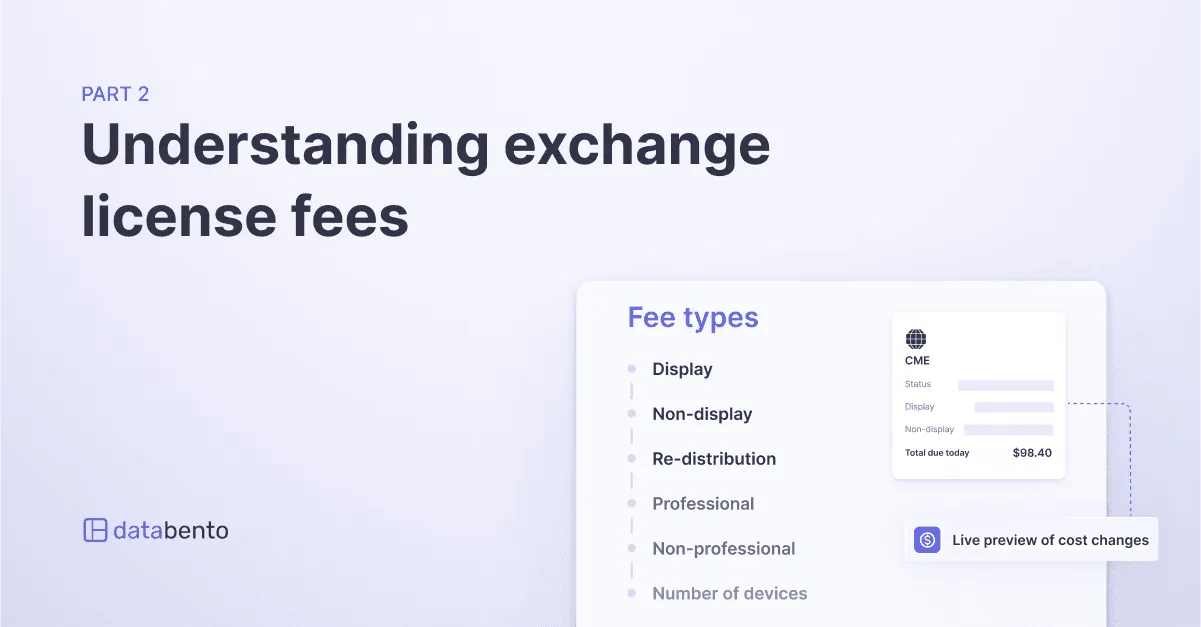Market data licensing FAQ part 2: understanding exchange license fees
The market data licensing process is complicated. To help navigate the various fee types and definitions, we created this comprehensive FAQ to help answer your questions and walk you through the licensing process.
You can access the other articles in the series via the links below or keep reading for a general information about exchange license fees. Feel free to connect with us if you have any further questions.

In this section, we'll share general information about exchange license fees. Read the article in full, or navigate to a relevant section via the highlighted FAQs below.
2.1 How do exchange license fees work?
2.2 Do you have a list of each exchange's license fees?
2.3 How can I decrease or avoid exchange license fees?
2.4 Why do some data vendors charge license fees and others don't?
2.5 Is it possible to avoid license fees by getting delayed real-time data?
Instead of a single fee, exchanges want to charge market participants based on how they're using data, so they set a list of rules and prices. For example, a high frequency trading firm will pay a different fee than a fintech app. The fees may be higher or lower depending on the venue, and there are some instances where a fintech app pays more than an HFT firm for access to the same data and vice-versa. Learn about common fee categories below, or see this article for details.
License fees are complex and ever-changing, and it's tough for any vendor to give concrete examples relevant to your specific situation. Even if you plan to work with a data provider, we strongly recommend speaking directly with the exchange to understand which subscriber category (and fees) your company falls under.
When speaking with the exchange, be sure to mention that you plan to use a third party data provider. This will usually lower your monthly license fee.
If you plan to work with Databento, we're happy to introduce you to our exchange reps to begin the licensing process. To save time, please provide us with your company's address so the exchange can assign a regional representative to speak with you.
Since fees are constantly changing, we've provided direct links to each exchange's website (when available) for the most up-to-date information.
These websites are complex and confusing. Thus, we've broken down the minimum Nasdaq real-time license fee as a loose example (but please don't quote us on this, as fees vary greatly):
Nasdaq's lowest fee for professional users is roughly $2,051/month. This is broken down as follows:
- Nasdaq TotalView Internal Distribution: $1,500 per month; plus
- Nasdaq Admin Fee: $100 per month (admin feeds are paid only once so if you have another subscription, this is waived); plus
- Nasdaq Depth Non-Display Usage Fee via Databento: $76 per subscriber per month.
- Note: $375 per non-display subscriber is only for RAW data delivery from a colo setup or an extranet setup.
Every venue has a different fee structure, so you can consider switching to a venue with lower fees (e.g. IEX is cheaper than NASDAQ for US equities data). However, the markets are fairly efficient: people usually tell us that they find greater value in markets that charge higher fees.
You can pay $0 license fees for real-time data in rare cases:
- Databento's DBEQ bundle offers US equities data with $0 exchange license fees. This dataset is a bundle of US equities proprietary feeds from NYSE Chicago, NYSE National, IEX, and MIAX Pearl Equities, which are free to license for distribution, display, and non-display applications and is ideal for web apps, brokerages, systematic trading, and cloud-based environments.
- In the FX space, some venues will waive the license fee if you're a trading participant in their market. This is not common in most other markets.
- Note that some vendors don't break down their fees, but that the license fee is always included in the overall fee. The data vendor must pay a monthly license fee on your behalf to each venue, so it must be included in order to break even.
- The only other way to avoid license fees is to make changes to your business strategy. For example, consuming data on a T+1 basis or changing your product to fall into a lower tier of fees. The significance of these changes is akin to a pivot, and thus it's not recommended unless you're in an exploratory phase of development.
All vendors must charge a license fee if it's required by the exchange or venue, or the exchange charges the fee directly to the user. Vendors like Bloomberg charge one overall fee that includes the monthly license fee. They'll pay the license fee to the exchange on your behalf.
- Note that some vendors hide the license fee until the end of the data-buying process to lock customers in.
- Note that a license is not required for historical data.
When available, delayed data is often cheaper than real-time data. However, a license is still required.
- Exchanges require a license for any intraday or delayed data.
- Anything T+1 (24 hours and earlier) doesn't require a license.
You can access the other articles in the series via the links below. Feel free to connect with us if you have any further questions.